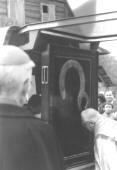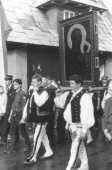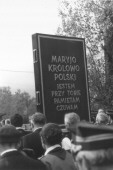The Black Madonna's Visit
Sunday 16 May 1999
The window decorations began appearing early last week--colored paper cut-outs in the shapes of crosses, madonnas, and various religious symbols (doves, chalaces, candles, etc.). By Thursday, 99% of the houses here had something in the windows. Then the roadside streamers began appear, tied to pieces of twine stretched between wooden stakes nailed into the shoulder of the road. The reason for all this: "Some image of significance--a madonna or something--is coming," Chhavi informed me after having talked to Kinga, a friend of who lives across the street. By the time we left Friday for Nowy Targ, a nearby city, the whole of Lipnica "centrum" was covered with decorations. And my suspicions had been confirmed--the Black Madonna of Czestachowa, the "queen of Poland."
When I came back from Nowy Targ Saturday afternoon the whole area was incredibly crowded--nuns, grandmothers, children, all milling about with the volunteer firemen in uniform and trying to keep everyone off the road itself. I went to the apartment, got my camera, and met Chhavi and Mamo (Polish for "Mom." I've been calling Kinga's mother "Mom" for so long now that anything else feels unnatural.) on the roadside. By that time, the fire department's band had joined the crowd, as well as a group of traditional musicians decked out in traditional Orawian "strój" (costume). A procession of altar boys came down from the church, followed shortly by archbishop of Kraków and at least fifty priests.
This whole time, I kept thinking, "This is all for a picture!" The Black Madonna certainly has an almost mythical air, and it bends the knees of even the most "secular" Pole. It's sometimes difficult for me to tell the difference in "adoration," "veneration," and "worship." They pray to Mary, but they don't worship her. They cross themselves when they see the black madonna, and kneel before statues of Mary and Christ, but don't consider this idolatry because they don't see it as worship. Veneration, they say, or adoration. Curious--one of the reasons there was a split in the early centuries (forming the Eastern Orthodox) was the question of icons . . .
 After
a few moments, the sound of a siren announced the coming of the idol--excuse
me, the madonna. It was housed in a Mercedes, the interior of which had been
decorated with rosaries and other symbols of worship. A priest got out, walked
to the back, and pressed a button set above the taillight of the van. The back
hatch of the van began rising silently, and the madonna began sliding out--all
automated, all very professional (and expensive, I'd assume). The priest/driver
then nodded to the priests of Lipnica who approached the madonna, knelt, and
kissed it after crossing themselves.
After
a few moments, the sound of a siren announced the coming of the idol--excuse
me, the madonna. It was housed in a Mercedes, the interior of which had been
decorated with rosaries and other symbols of worship. A priest got out, walked
to the back, and pressed a button set above the taillight of the van. The back
hatch of the van began rising silently, and the madonna began sliding out--all
automated, all very professional (and expensive, I'd assume). The priest/driver
then nodded to the priests of Lipnica who approached the madonna, knelt, and
kissed it after crossing themselves.
 The
madonna itself was housed on a special frame from which protruded two poles
(much like the famed Ark of the Covenant) which were used to carry the queen
of Poland. She was hoisted on firemen's shoulders, and the crowd began singing,
"Swieta Maryja, Matka Boze, witamy ciebie." (Holy Mary, Mother
of God, we welcome you.) They carried the madonna down to the church and
all went inside for a special two hour mass.
The
madonna itself was housed on a special frame from which protruded two poles
(much like the famed Ark of the Covenant) which were used to carry the queen
of Poland. She was hoisted on firemen's shoulders, and the crowd began singing,
"Swieta Maryja, Matka Boze, witamy ciebie." (Holy Mary, Mother
of God, we welcome you.) They carried the madonna down to the church and
all went inside for a special two hour mass.
All this was very curious. It seems impossible for them to deny at the very least that they are within a hair's breadth of worshipping this thing. All the decoration, the pomp and displays of devotion. Of course all this was for the sake of the fifty or so priests from outside the village that came along with the madonna, but I would argue that the inhabitants did this to show the priests how devoted they are to the madonna. Anyway, all this was for a picture.
 And
I've saved the real irony of the situation for the end: I found out at the beginning
of the processional that it's not even the original, but a replica! The real
queen of Poland sits in her shrine in Czestachowa, where other people are bowing
down to the real picture, worshipping it and not some imposter. A friend assured
me: "But there's only one copy! This is the only copy!" Still,
a fake is a fake . . .
And
I've saved the real irony of the situation for the end: I found out at the beginning
of the processional that it's not even the original, but a replica! The real
queen of Poland sits in her shrine in Czestachowa, where other people are bowing
down to the real picture, worshipping it and not some imposter. A friend assured
me: "But there's only one copy! This is the only copy!" Still,
a fake is a fake . . .
Just a few moments ago, there was a report on the radio about the madonna's visit to Lipnica. Our head priest--I can't remember his name--got quite a bit of radio time to talk about the significance of this (which had been in the works since September). He said something about being able to see the results of the visit, seeing how long the people will remember why Mary (he referred to the painting constantly and consistantly as if it were a person) came to Lipnica. Or rather, why the replica of the painting of Mary was brought to Lipnica.
 After
a few moments, the sound of a siren announced the coming of the idol--excuse
me, the madonna. It was housed in a Mercedes, the interior of which had been
decorated with rosaries and other symbols of worship. A priest got out, walked
to the back, and pressed a button set above the taillight of the van. The back
hatch of the van began rising silently, and the madonna began sliding out--all
automated, all very professional (and expensive, I'd assume). The priest/driver
then nodded to the priests of Lipnica who approached the madonna, knelt, and
kissed it after crossing themselves.
After
a few moments, the sound of a siren announced the coming of the idol--excuse
me, the madonna. It was housed in a Mercedes, the interior of which had been
decorated with rosaries and other symbols of worship. A priest got out, walked
to the back, and pressed a button set above the taillight of the van. The back
hatch of the van began rising silently, and the madonna began sliding out--all
automated, all very professional (and expensive, I'd assume). The priest/driver
then nodded to the priests of Lipnica who approached the madonna, knelt, and
kissed it after crossing themselves. The
madonna itself was housed on a special frame from which protruded two poles
(much like the famed Ark of the Covenant) which were used to carry the queen
of Poland. She was hoisted on firemen's shoulders, and the crowd began singing,
"Swieta Maryja, Matka Boze, witamy ciebie." (Holy Mary, Mother
of God, we welcome you.) They carried the madonna down to the church and
all went inside for a special two hour mass.
The
madonna itself was housed on a special frame from which protruded two poles
(much like the famed Ark of the Covenant) which were used to carry the queen
of Poland. She was hoisted on firemen's shoulders, and the crowd began singing,
"Swieta Maryja, Matka Boze, witamy ciebie." (Holy Mary, Mother
of God, we welcome you.) They carried the madonna down to the church and
all went inside for a special two hour mass. And
I've saved the real irony of the situation for the end: I found out at the beginning
of the processional that it's not even the original, but a replica! The real
queen of Poland sits in her shrine in Czestachowa, where other people are bowing
down to the real picture, worshipping it and not some imposter. A friend assured
me: "But there's only one copy! This is the only copy!" Still,
a fake is a fake . . .
And
I've saved the real irony of the situation for the end: I found out at the beginning
of the processional that it's not even the original, but a replica! The real
queen of Poland sits in her shrine in Czestachowa, where other people are bowing
down to the real picture, worshipping it and not some imposter. A friend assured
me: "But there's only one copy! This is the only copy!" Still,
a fake is a fake . . .